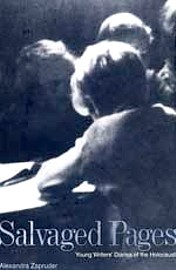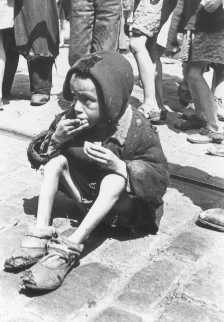Essay (back
to top)
By the early 1940s, Germany began to occupy Europe, wanting to unite the German people under one perfect, pure Aryan regime. However, one religion, named a race under Hitler’s Supplementary Decree of Reich Citizenship law in 1935, was facing extermination of their rights and liberties. The Jewish people of Germany and surrounding nations were forced under antisemitic laws to suspend cultural and intellectual life, to close businesses, give up property and wealth, and face a steadily growing hatred. Yet adults were not the only ones affected by Hitler’s Third Reich, children were too. Often, childhood is thought to be a time filled with innocence, surrounded by the restless autumn days of school while they dream for the long, warm summer days of leisure. Hitler changed all those dreams and shattered their innocence. Two questions are raised in my mind when looking at Hitler’s Third Reich: what was daily life like for a Jewish child; and what were their emotional responses to their surroundings? Was it bitterness, hatred, hopelessness, or was it acceptance? Salvaged Pages: Young Writers’ Diaries of the Holocaust, answers these questions and more.
Consisting of 504 pages, with fourteen individual diaries, the authors’ ages ranging from twelve to twenty-two, Salvaged Pages unites a “wide range of writers, whose social, cultural, and religious backgrounds and whose wartime experiences reflect a multiplicity of perspectives”(11). The diarists offer an insight into a changed Europe, a Europe where pains of hunger, fear, and bewilderment were constant companions to one nation of people. However, the diaries could not stand on their own, and through years of research, Alexandra Zapruder collected and edited Salvaged Pages.
The goal of Salvaged Pages was not to “provide a romanticized image of the historical significance for literary strengths…but to provide a sample of the extent that would begin to suggest the variations, complexities, and echoes that exist within the whole” (xvii). To help readers place the diary within the context of the Holocaust, Zapruder precedes each diary with the biographical background of the writer and an analysis of the diaries’ content as she does not include the full diary in her work. However, what Zapruder does not provide in her summary is the emotional rollercoaster of the child or young adult writer, she leaves that up to the readers to find and experience on their own. By immersing themselves into a diary, readers are transported to another time and place, where they can witness first hand an emotional world and shattered innocence of a Jewish child or young adult where previously it had not been preserved by other sources. Zapruder’s goal in writing Salvaged Pages to present a wide range of writers, but did not truly present this, as there was a common thread of emotion throughout the authors. I state this because there were other Jewish children, those who were refugees, those who were smuggled into other countries, and there also hidden children within Aryan families.
Drawing on sources from individuals and archives, there are four diaries that are distinct in Salvaged Pages, all of them from Poland. Two diaries in Zapruder’s research feature anonymous writers, one is a girl, the other a young man. Although their lives were two years apart in the Lodz Ghetto, their records stand alone for their personal hardships, emotional journey, and lost childhood. Written on the inside of the girl’s journal are two names, Esterka and Minia, unknown is which sister penned the words. From family records, Zapruder can tell that is possible that the youngest member of her family put her thoughts to paper. Her diary started in 1942 with no obvious reason, reporting the everyday events around her, and ended just as abruptly. The unknown young man’s diary is of a greater depth and wonder. Offering a very different point of view of the events of the ghetto, the young man who wrote this diary expressed his education by writing in four languages off and on through the years. What is unique about the young man’s diary is that it is written in the margins of a French book Les Vrais riches – The Truly Rich (361).
Outside the ghetto, Zapruder turns towards Polish towns and villages, drawing in a further emotional complexity. Dawid was only twelve years old when the war started and readers can see his innocence shattered as the world he knew changed around him as his father was arrested multiple times and fellow Jews were murdered. Writing on events that surround his family and village of Krajno, he expresses a wide range of events that occurred at the beginning of the war, merging his emotional ties with simply stated facts of village life and news. Elsa, another girl, lived in Stanislawow, a town in the province of Eastern Galicia. By 1941, Germany and its troops had completed their occupation of Poland and later that year the ghetto was established. Before her family was forced into the ghetto, Elsa began her diary. Throughout her diary, animosity, love, and concerns flow between each of the diary entries, allowing readers to see the emotional impact of her daily life and her young adolescent years crumble around her.
Daily life for all four writers was a vast and different experience. Not only because of the perspective of the diary, but also because of the years that separate them, and the many changes happened in Hitler’s Reich. Dawid, the earliest writer, starts in March 1940, opening by recalling his walk in the village earlier in the morning, and his observation of a notice. He states that he “quickly went up to read it. The new notice said that Jews may under no circumstance travel in vehicles (the railway had long been forbidden)” (276). The obvious offhand remark he makes about not being able to travel the railways in connection to now not being able to travel in vehicles shows that Dawid already appears as a child who accepted hardship and loss of freedom as part of his daily life. Despite the apparent acceptance of racism in his life, Dawid repeatedly writes of raids, random arrest, forced labor, and murders. In a 1942 entry he wrote, “they finished them off in Bieliny (they were certainly shot). Already a lot of Jewish blood had flowed in Bieliny” (291). Dawid is not the only writer who spoke of mistreatment. In the Lodz ghetto, the young anonymous man focused his words on not only his despair and hopelessness but also that of his surroundings. In 1944, he writes “And still Getto, and still subject to infernal sufferings, and still far from being able even to dream about a human life, nay, a piggish life, even that is unattainable” (371) This lack of hope is a strong undercurrent throughout all four diaries. Coupled with the offhanded and sometimes intentionally sarcastic remarks about life inside and out of the ghetto, shows that daily life for Jewish children and young adults in Poland completely changed the writers’ innocent perspective.
Emotionally, daily life affected each of the young writers. Elsa, who lived outside the ghetto when she began her diary, shows the greatest range of emotional responses to her surroundings. Her first diary entry was in December 1941, with a recollection of a letter sent by her cousin in Italy. When her cousin talks about coming home to Poland to take care of his father’s death, she states how he is naive to come back into “the lion’s mouth” (306). Throughout this entry, an undercurrent of bitterness trails her words, noticeable to readers when she states, “he doesn’t know what it’s like here” when her cousin asks that flowers be placed on the grave” (306) Elsa not only imparts bitterness through her diary, but also sheer resentment towards her surrounding situation, especially when she and her family are forced to move to the ghetto. Elsa’s resentment is clearly expressed when she directs her anger towards the Jewish Council, where she writes that they consist of “crooks and noisy windbags” (307). She further expresses anger when she condemns them for living well while certain kinds of people die of starvation and cold (307/8). The anonymous girl’s first entry is undated and fragmentary, but hopelessness underscores her words, contributing not only her emotional journey, but also daily life. She writes, “human life is so miserable, but one still fights for it” and throughout her entries, readers can see this fighting spirit. When she found out that her sister’s friend was deported, she didn’t expand her thoughts beyond stating that she is “completely broken,” instead, she focuses on “how much she [the friend] has already suffered, how much she has wrestled with difficulties (232). Throughout her diary she keeps her emotions limited from the pages, instead expressing how much suffering and loss those around her have endured. Thus her diary stands emotionally apart from Elsa’s egocentric dialogue. In March 1942, the anonymous girl wrote,
we Jews from the Ghetto work so hard, help them in the war…they treat us worse then slaves. Is this life? Isn’t death better? I had to restrain myself in order not to shout some insults. You have to be quiet although your heart is breaking. (241)
This simple statement is so strikingly different from Elsa’s obvious hatred that readers can see how differently Jewish children and young adults dealt with emotional changes in their lives. Emotionally, the young girl was drawn more to the people in her surroundings and family, which she really did not reflect on a personal level. In contrast, Elsa’s underlying bitterness towards her cousin’s letter, and anger towards the Jewish Council for living well, shows that on some level she was more attuned towards being self centered in order to survive. While each of the diaries can stand on its own emotionally because of each writer’s own experiences, the diaries are usually filled with the same thoughts and desires, like that for food, as hunger was a constant companion as it was rationed. However, some writers emotions occasionally ran to the surrounding situations and people, where they often dreamed of a different place and life outside of the ghetto.
Throughout the 1930s and 40s, Jewish children were forced to lose their innocence as waves anitsemitism grew under Hitler’s increasing power. Poland, a neighboring nation to Germany, would see its Jewish population slowly murdered during this time. Ensuring that their sacrifices, their fears, and their lives were not lost to history, Alexandra Zapruder spent years researching children and young adult diaries. The young anonymous girl shows that bravery was an emotional strength no matter how much she wanted to rail at her German enslavers. Elsa, a young woman, also forced from her home, speaks of the bitterness that life has dealt her and her family. Although a complicated young woman, her diary brings forth the dreams and hopes that were a loss, not only to her, but also to those other young women around her. Dawid, the youngest, had yet to grow into his adolescence, but over night, he was forced to become an adult. With an acceptance that most children might not show or accept, his loss of freedom and daily life was alleviated by the love of his family. Although his age is unknown, the young man showed the greatest depth in his writing. While accepting the pains of hunger and railing against the injustice of the ghetto, he was still able to dream of a better place. In Salvaged Pages: Young Writer’s Diaries of the Holocaust, Zapruder made sure that their daily lives, their daily struggles, and ever-changing emotions made them unforgettable in readers’ minds and hearts.
|


